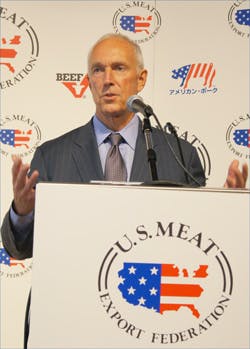USMEF Addresses Export Issues with Japanese Media
Published: Apr 12, 2012
USMEF President and CEO Philip Seng and several members of the USMEF-Japan team addressed a broad spectrum of export-related topics with a packed house of Japanese and international media yesterday, ranging from the anticipated level of U.S. red meat exports this year and USMEF’s Japan Relief and Recovery Effort to Japanese consumer trends and growing consumer approval of American beef and pork.

Seng noted that rising input costs, along with a severe drought in several cattle-producing regions in the United States, are expected to contribute to a decline in cattle numbers this year.
Despite that, USMEF is projecting a roughly 25 percent rise in U.S. beef exports to Japan this year based on the ongoing risk assessment by Japan’s Food Safety Commission that could lead to allowing the import of U.S. (and Canadian) beef from cattle older than 20 months of age.
“I’m very enthused that Japan’s Food Safety Commission is looking at this 20-month level and possibly expanding beyond it,” said Seng. “We expect the movement sometime this year.”
In 2011, U.S. beef exports to Japan reached 158,646 metric tons (349.8 million pounds) valued at $874.4 million. Despite increases of 27 percent in volume and 37 percent in value over 2010, they remain substantially below the peak of 513,174 metric tons (1.1 billion pounds) valued at $1.6 billion set in 2001, prior to discovery of bovine spongiform encephalopathy (BSE) in Japan and the U.S.
Japan also is the top value market for U.S. pork exports, last year buying 493,313 metric tons (1.1 billion pounds) valued at just under $2 billion. Tazuko Hijikata, USMEF-Japan’s senior manager for consumer affairs, told the media gathering that the Japanese today eat four times the pork they did in 1995, and U.S. pork has been the No. 1 consumer choice for imported pork for seven consecutive years.
She also explained that while Japanese consumers are extremely safety conscious when it comes to food, their confidence in U.S. beef has increased by a factor of four since 2006. “As the volume of imports has increased, so too has confidence and trust in U.S. beef,” said Hijikata. “The more people see U.S. beef at retail and in restaurants, the more they trust it, which helps encourage consumer demand.”
Japanese consumers are less accustomed than their American counterparts to roasting larger cuts of red meat in an oven. Hijikata explained that one of USMEF-Japan’s initiatives this year is helping educate consumers on cooking styles and recipes for larger cuts. Celebrity chefs and cooking bloggers are being enlisted in this education effort.
USMEF’s programs for the Japanese food trade were discussed by Takemichi Yamashoji, senior marketing director for USMEF-Japan. He noted that the growing popularity of branded pork in Japan – supporting more than 400 brands at retail – has led to a focus on the development of multiple new U.S. pork brands introduced in Japan over the past year.
Yamashoji explained that USMEF is collaborating with a number of retailers and foodservice providers on branded pork promotions and they have received high marks from consumers. On the beef side, he noted that similar promotions are being set up with yakiniku industry associations.
The press gathering also addressed USMEF’s Japan Relief and Recovery Effort, which was funded by U.S. beef and pork industry organizations and supplied 190,000 hot meals containing American beef and pork to people displaced by last year’s devastating earthquake and tsunami. The Relief and Recovery Effort was accomplished in collaboration with numerous Japanese food service, retail and nonprofit partners.
